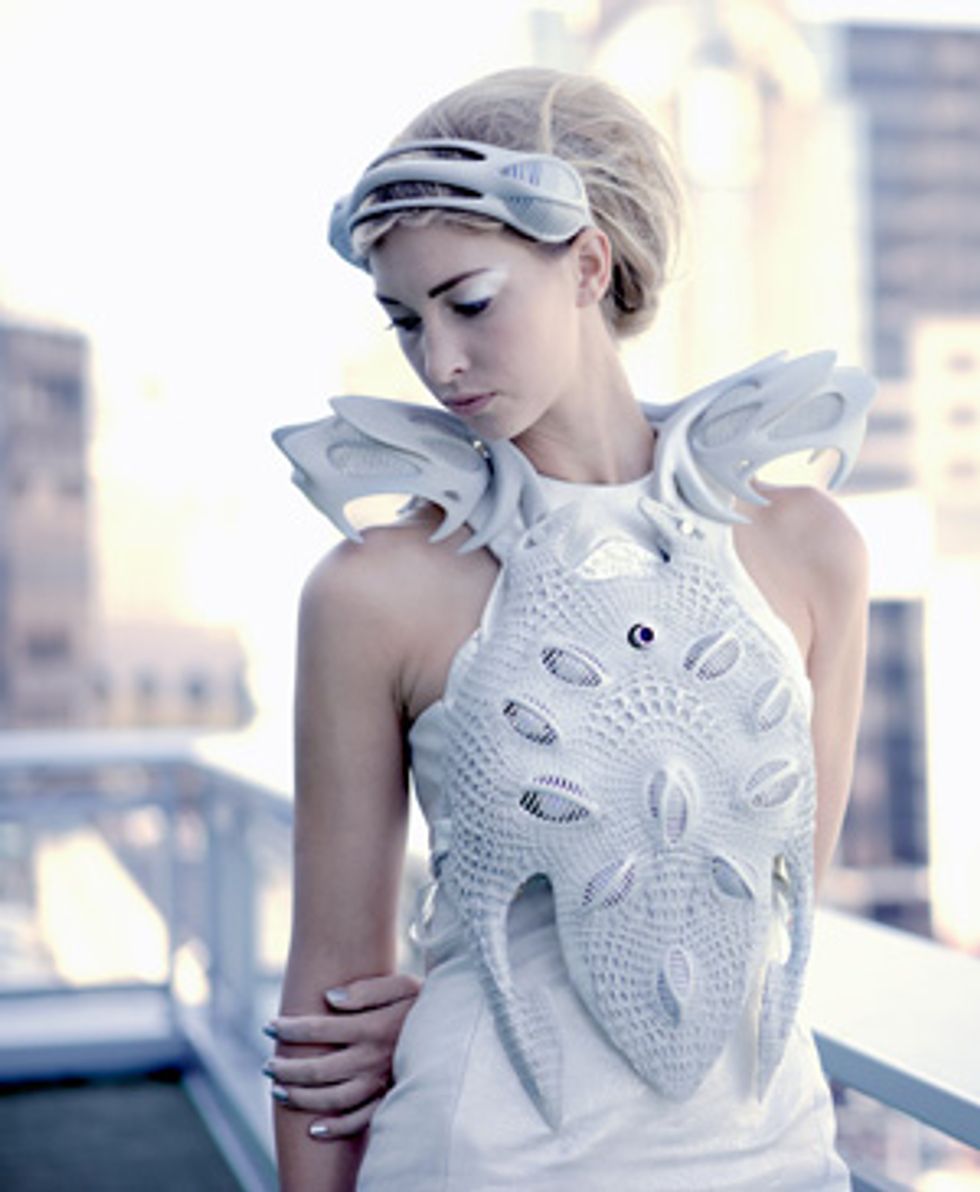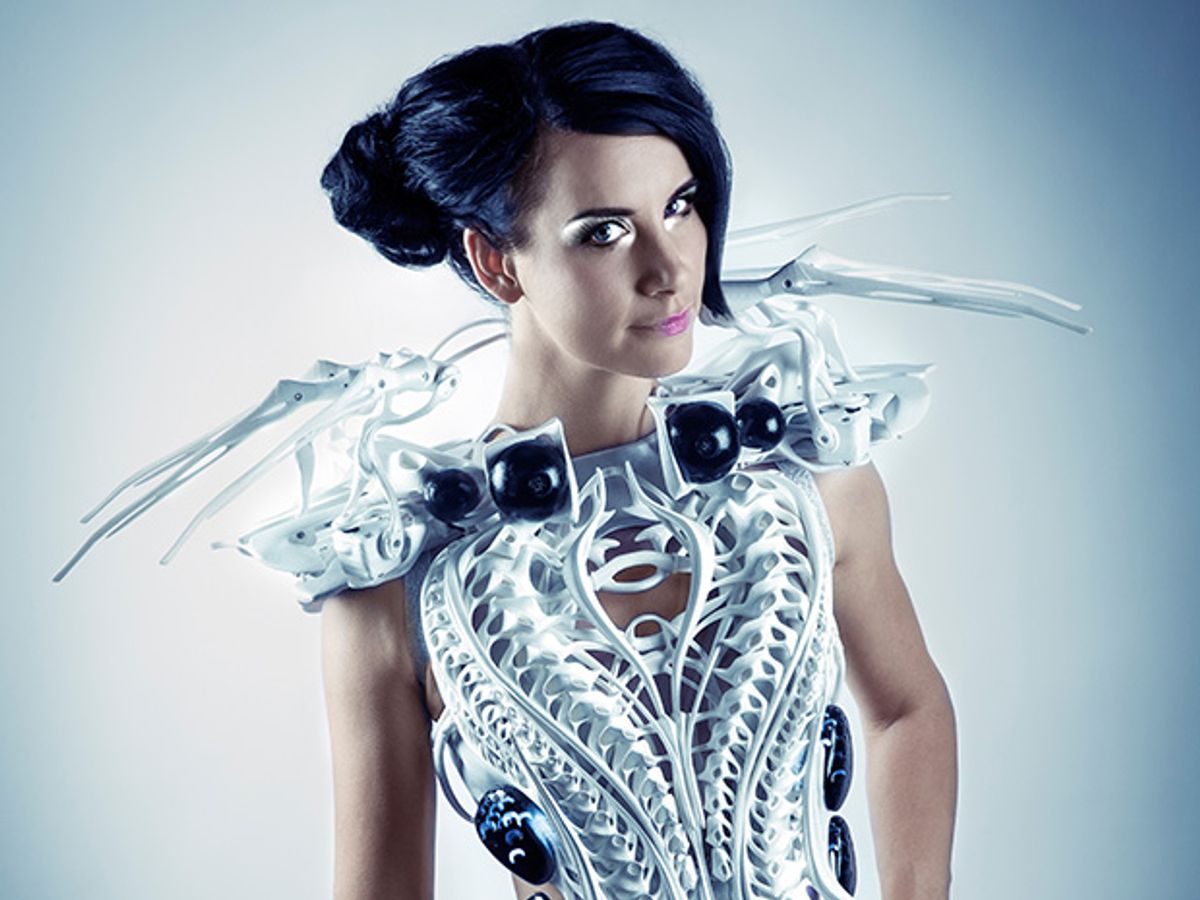The current wave of wearable computing has mostly been about putting electronic smarts into fashion accessories of various forms: fobs, wristbands, gloves, shoes, and glasses. Meanwhile, the actual clothes we wear have been remarkably untouched by the digital revolution. But Anouk Wipprecht is leading the charge among high-tech designers to change that. She is creating clothes that can sense and respond to the person wearing them and the environment surrounding them.
Like most high-end fashion designs, Wipprecht’s projects are more about provoking discussion than trying to create something that can be purchased in a store. She is using her conceptual designs to explore what clothing could be, using increasingly elaborate technologies to push the boundaries of clothing’s traditional dual roles of protection and display. For example, her Spider Dress 2.0 uses a 3-D-printed skeletal bodice equipped with sensors and motorized “limbs.” Invade the wearer’s personal space by standing too close too quickly and the limbs will extend to reestablish a comfort zone.
The Spider Dress 2.0 was built in partnership with Intel, which points to the dress as an eye-catching demonstration of the abilities of its new, embedded Edison chip. This is only one of several partnerships Wipprecht has formed with technology companies, as she seeks to expand the range of possibilities for what she calls “fashion-tech.”
As a child, she was drawn to fashion, she says: “I found it fascinating how people used fashion to express and communicate their style and identity.” By the time she was 14, she was already experimenting with fabrics and design, and just a few years later she was working in the fashion industry of her native Netherlands. “I didn’t have rich parents, so I educated myself,” says Wipprecht, and without access to expensive materials or tools, she “had to be creative.” But she grew discontented: “After a few years, I got bored with the materials because they didn’t naturally interact, they didn’t do anything…that’s why I got into robots.”
In particular, Wipprecht was interested in robotics that could be intertwined with the human experience. “I didn’t want robots like R2-D2,” she explains. “I wanted robots to see like us and feel like us.“

As part of her robot experiments, Wipprecht started working with microcontrollers such as the Arduino, and she saw how they could be used to create behaviors. Soon she was bringing her experience back to fashion: “I started to implement little motors into fabrics, which in return started to move and crawl.” As her fashion experiments progressed, she says she “started to notice that system behavior is really important, so I studied interaction design.” She went to Sweden and studied under David Cuartielles, one of the original creators of the Arduino, to learn more about electronics.
Her designs garnered attention on the international stage, not least when she was commissioned to create an interactive outfit for the lead singer of the Black Eyed Peas for the 2011 Super Bowl halftime show. Wipprecht began incorporating more and more sophisticated sensors and processing into her designs so that they could react to the wearer’s brain waves, for example, as with her Synapse dress.
Indeed, Wipprecht has never been content with the technology available to her, which is what has led her to her tech-industry partnerships. She wants her clothes to be smarter, more perceptive, like a second skin acting on behalf of the wearer. She continues to expand her garments’ circle of awareness, both in terms of physical distance and depth of perception. Wipprecht is now beginning to explore using machine learning so that her clothes can react in intelligent and subtle ways to the wearer’s social experience, and a collaboration with Google is currently in the works.
Wipprecht finds that her keys to success are curiosity, being willing to work across disciplines, and having a clear mission. “Whatever triggers your attention, go for it,” she says. “A lot of engineers ask me, ‘How do I do design?’ I say, just go out and make stuff. And a lot of designers ask me, ‘How do I do technology?’ Well, just buy an Arduino and play with it. Experiment. Explore. But if you don’t have a mission in mind, it’s hard to succeed.”
This article originally appeared in print as “Anouk Wipprecht.”
